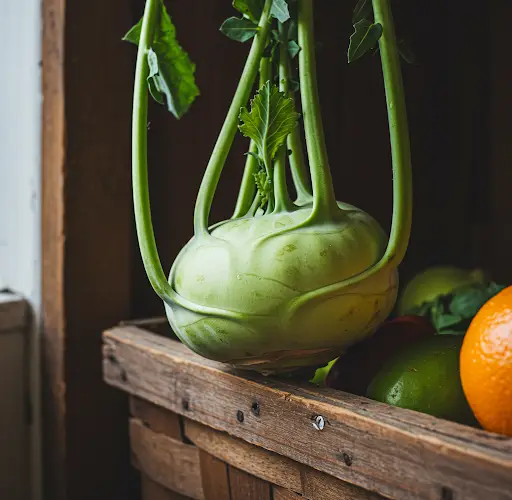How to Grow Kohlrabi in a Hanging Storage Basket
If you’re looking for a creative and space-saving way to grow fresh vegetables at home, kohlrabi is a great choice—especially when grown in a repurposed hanging storage basket. This method is perfect for gardeners with limited ground space, and it adds a unique decorative touch to your balcony or patio.
Kohlrabi, also known as German turnip, is a cool-season vegetable related to cabbage and broccoli. It produces a swollen stem just above the ground that can be eaten raw or cooked. With a little care and the right setup, you can successfully grow kohlrabi in a hanging basket—even if you’ve never gardened before.
Why Grow Kohlrabi in a Hanging Basket?
Hanging baskets aren’t just for flowers. With the right container and growing medium, many compact vegetables—including kohlrabi—can thrive in this setup. Here’s why it’s worth trying:
-
Space-saving: Perfect for balconies, rooftops, or apartments with no ground soil.
-
Recycled materials: Makes use of old storage baskets or hanging organizers.
-
Good airflow: Elevation helps prevent pests and diseases.
-
Decorative: Adds greenery and interest to vertical spaces.
What You’ll Need
-
An old plastic or metal mesh storage basket (minimum 10–12 inches deep)
-
Coco liner or breathable fabric to hold the soil (e.g., burlap, jute, or old T-shirts)
-
High-quality potting mix
-
Organic compost or vermicompost
-
Kohlrabi seeds or seedlings
-
Watering can or spray bottle
-
Strong rope or chain for hanging
-
A sunny location (at least 4–6 hours of sunlight daily)
Step 1: Prepare the Basket
Choose a storage basket with enough depth to allow root development and stability for the plant. Line the inside with a breathable material like coco liner or fabric to hold the soil while allowing excess water to drain.
If your basket has large holes, add a second layer or use a finer fabric to prevent the soil from falling through.
Step 2: Mix the Growing Medium
Kohlrabi needs well-drained, nutrient-rich soil to grow healthy bulbs. For best results, use a lightweight, breathable potting mix. Here’s a simple blend:
-
40% garden soil or loamy topsoil
-
30% compost or vermicompost
-
20% coco peat or coconut coir
-
10% sand or perlite for drainage
Mix thoroughly and moisten slightly before filling the basket.
Step 3: Planting Seeds or Seedlings
If you’re starting from seeds:
-
Sow 2–3 seeds in the center of the basket about half an inch deep.
-
Water lightly to settle the soil.
-
Once the seeds germinate (in 5–10 days), thin them out by removing the weaker seedlings, leaving one strong plant per basket.
If using seedlings:
-
Gently transplant one healthy kohlrabi seedling into the center of the basket, taking care not to damage the roots.
Step 4: Choose the Right Location
Hang your basket in a location that receives at least 4–6 hours of sunlight each day. Kohlrabi grows best in cool to mild weather, ideally between 10°C to 25°C (50°F to 77°F).
Make sure the basket is securely fastened with a sturdy rope or chain, especially if it’s exposed to wind.
Step 5: Watering and Maintenance
Water regularly to keep the soil evenly moist but not soggy. Hanging baskets tend to dry out faster than ground containers, so check daily, especially during warmer weather.
To keep the plant healthy:
-
Feed with diluted organic liquid fertilizer (like compost tea or fish emulsion) every 10–14 days.
-
Watch for pests like aphids or cabbage worms. Treat with neem oil or a mild soap solution if needed.
-
Keep the area around the base of the plant clean and dry to avoid fungal infections.
Step 6: Growth and Harvest
Kohlrabi grows fairly quickly. You’ll notice the stem begin to swell after about 3–4 weeks. The bulb is usually ready to harvest in 45–60 days after sowing, depending on the variety.
Harvest when the bulb reaches 2–3 inches in diameter—larger bulbs can become tough and woody. Use a sharp knife or scissors to cut the stem at the base. The leaves are also edible and can be cooked like spinach or kale.
Final Tips
-
You can grow multiple baskets at once for a continuous harvest.
-
Rotate the basket occasionally if sunlight hits unevenly.
-
After harvesting, refresh the soil with compost before planting a new crop.
-
Ideal companion plants for hanging baskets include lettuce, herbs, or radishes.
A Creative Way to Garden in Small Spaces
Growing kohlrabi in a hanging basket is a fun and sustainable gardening project. It’s ideal for small-space dwellers who want to grow their own food using recycled materials. With just a bit of care, you’ll be rewarded with crisp, homegrown kohlrabi that’s perfect for salads, stir-fries, or roasting.



